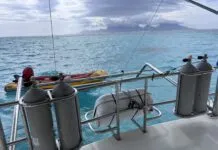
My summer cruise took me up to the Discovery Islands just north of Desolation Sound off the coast of British Columbia with sailing buddy Paul aboard Natasha, my 1978 Islander Bahama 30. We met up with Chris sailing solo aboard his 2005 Sabre 386 in Cameleon Harbour, a remote, forested anchorage far from the busy life ashore. A pleasant evening was shared over dinner and drinks as the sun set over nearby mountain tops.
To continue reading this article or issue you must be a paid member. Sign in
Join Practical Sailor
Get full access to Practical-Sailor.com – more than 4,000 articles – for just $34.
Join today and save 42% off our full price.


































The usual problem is getting the hose to release from its fitting. Heat applied gently has worked for me. Thankfully, I have only had to work at the dock where electricity to power a heat gun was available.
Reassembly using silicon (brake) grease will ease the process the next time. Petroleum grease will damage hose. Syl-Glide is my go to. Also works as a lubricant and rejuvenator for any rubber gasket (hatches, fridge, etc.)
Using the dinghy pump to apply reverse pressure to clear the debris is very clever. So is the using a length of hose to eliminate the elbow. Thanks!
Thanks for he comment. I’ve never used brake grease on marine hoses, but it should work. I’ve used dielectric grease in the past, probably the same basic silicon structure and doesn’t appear to damage the hose over time. I’ve been using it on the “T” roof on my car for years to stop the squeak of the rubber gasket against metal, no damage to the rubber.
I had a similar problem in my A/C cooling circuit. I replaced the sharp 90 degree elbow with a Groco FFC Series Full-Flow Pipe To Hose Adapter – 90 deg. which is a sweeping elbow. End of problem.
Thanks for the comment. I didn’t know that part existed! Now I do. However, there wouldn’t be enough clearance in this situation for that fitting anyway, but good to know for future problems like this.
I’ve used the boat’s air horn to force air thru the raw water intake and blow out whatever was clogging it. Just fit the horn over the hose running to the thru hull and hit the trigger. If it works, it’s fast and easy.
I went with the bronze “T” with a cap. I have a 20 gauge shotgun brass cleaning brush on a short rod. When the intake clogs I just close the seacock, remove the plug from the “T” and insert the cleaning rod. I then open the seacock and rapidly push the brush up and down a few times to clear the obstruction. When the obstruction clears water starts flowing out the top of the “T” and I quickly remove the rod and close the seacock. Replace the plug and you are ready to go. Water intrusion is minimal. I have never had a clog between the “T” and the raw water strainer. I also added a water flow meter so I know if the line is clogged before the engine overheats.